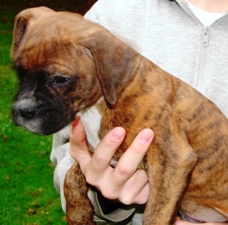Oliveira's Renegade Boxers
FACTS & QUESTIONS
Q? Are boxers good with children?A: Boxers love children. They make great family pets because they love people, particularly children.Q? Are boxers easy to train?A: Boxers are very intelligent dogs, however, they do get bored easily. Training sessions should be kept to a short period of time and be as non-repetitive as possible.Q? What colours do boxers come in?A: Boxers come in Brindle, fawn and white. Technically, there are only two colours – brindle and fawn. Boxers may or may not also have white markings (known as "flash"). The white boxer is simply a fawn or a brindle with very extensive white markings, covering the whole or most of the coat . Fawn boxers have a solid fawn colour coat, in shades that range from pale tan to deep deer red. Brindle boxers have the same fawn ground colours, overlaid with various degrees of dark striping. The correct term for any brindle is ... well... brindle - BUT, depending on the fawn ground colour, concentration of striping and local terminology, they can be variously described as "light", "golden", "fawn", "red", "mahogany", "dark", "reverse" or "seal" brindle.Black boxers do not exist – the colour gene responsible for black coat colour does not exist within the boxer breed (much like brindle does not exist for labradors, or harlequin for rottweilers). If you “see” a "black" boxer, it must either be a very dark brindle or a mixed breed. Q? What does "flashy" mean?A: Flash refers to any white markings on a boxer. A plain or classic boxer has little white, generally confined to the feet and chest. A "flashy" boxer is one with more extensive white markings, extending some distance up the legs, on the face and possibly on the neck. Depending on the extent of the white markings, dogs are sometimes described as "flashy" or "semi-flashy". Flash is actually lack of pigmentation and is due to the dog having one copy of the extreme white spotting gene. A dog with two copies of that gene will be predominantly or completely white (ultra flashy!). Q? What should my puppy weigh, how big will he get, and when will he finish growing?
A: In general, boxers will grow in height until around 12-15 months of age and then continue to fill out until they are two or three years old. The growth plates will not fully close until 18 months though, so be very careful to avoid over-exercising your puppy until this age.
Boxer puppies grow at remarkably varying rates so it's meaningless to try to estimate what a puppy should weigh at any given age. Bigger puppies don't always mean bigger adults though. The final size a dog will reach is determined by genetics, so the best indication of how large any particular puppy will become is the size of his parents, any older siblings, and other close relatives.
A: In general, boxers will grow in height until around 12-15 months of age and then continue to fill out until they are two or three years old. The growth plates will not fully close until 18 months though, so be very careful to avoid over-exercising your puppy until this age.
Boxer puppies grow at remarkably varying rates so it's meaningless to try to estimate what a puppy should weigh at any given age. Bigger puppies don't always mean bigger adults though. The final size a dog will reach is determined by genetics, so the best indication of how large any particular puppy will become is the size of his parents, any older siblings, and other close relatives.

THE BOXER
The Boxer was originally bred for the purpose of hunting. The first Boxers were bred to be fierce but these traits are not seen today.
Boxers today tend to be gentle, loving and energetic dogs. They are stocky dogs of a medium size. Male Boxers will grow to an average height of 22 to 25 inches and weight of 60 to 70 pounds. Females Boxers will reach an average height of 21 to 24 inches and weight of 53 to 65 pounds.
Boxers have an average life span of 11 to 14 years. Their coats are smooth and shorthaired, making Boxers easy to groom. In fact, Boxers tend to be 'clean freaks' and will clean themselves regularly.
Copyright 2010